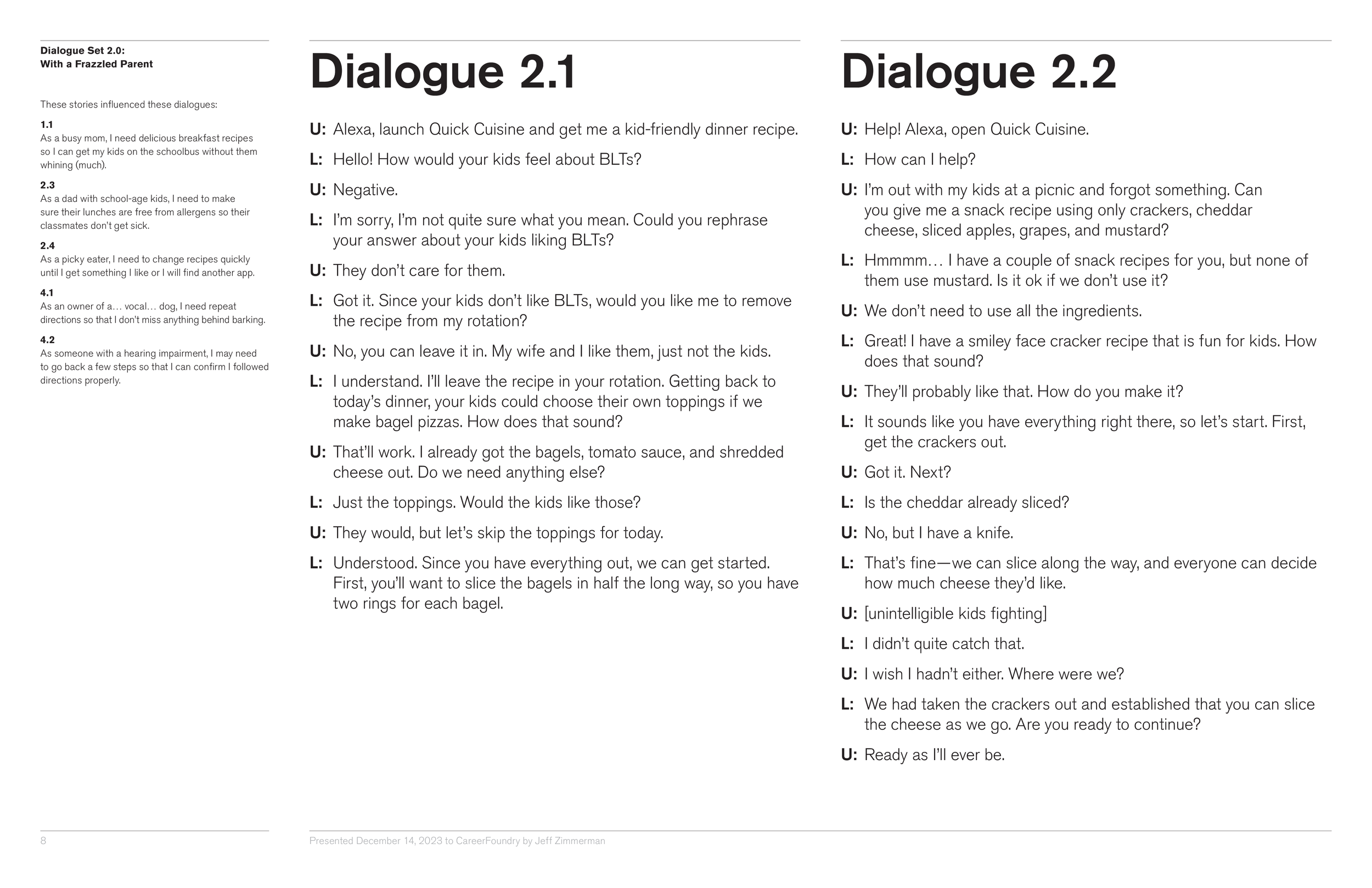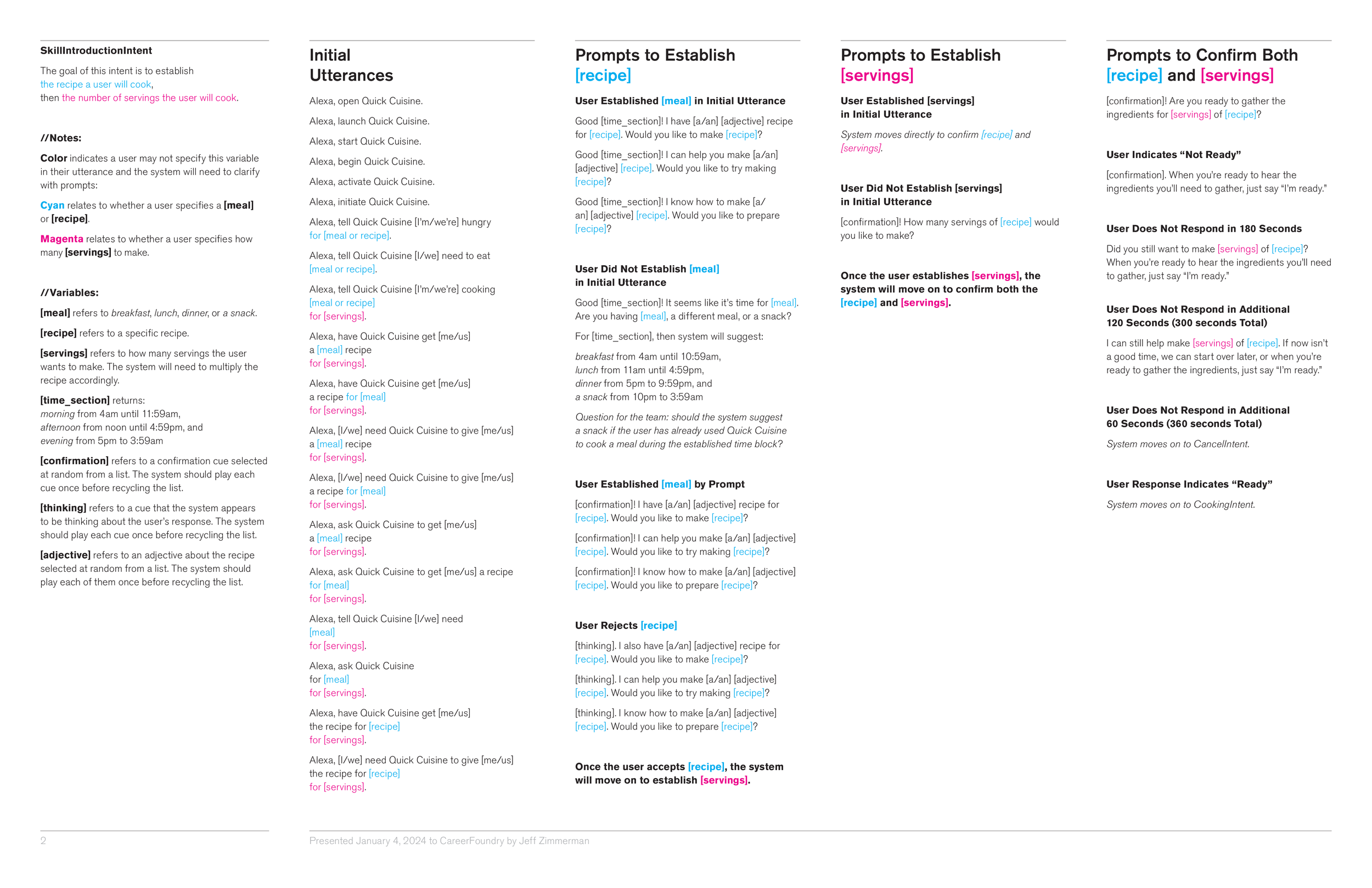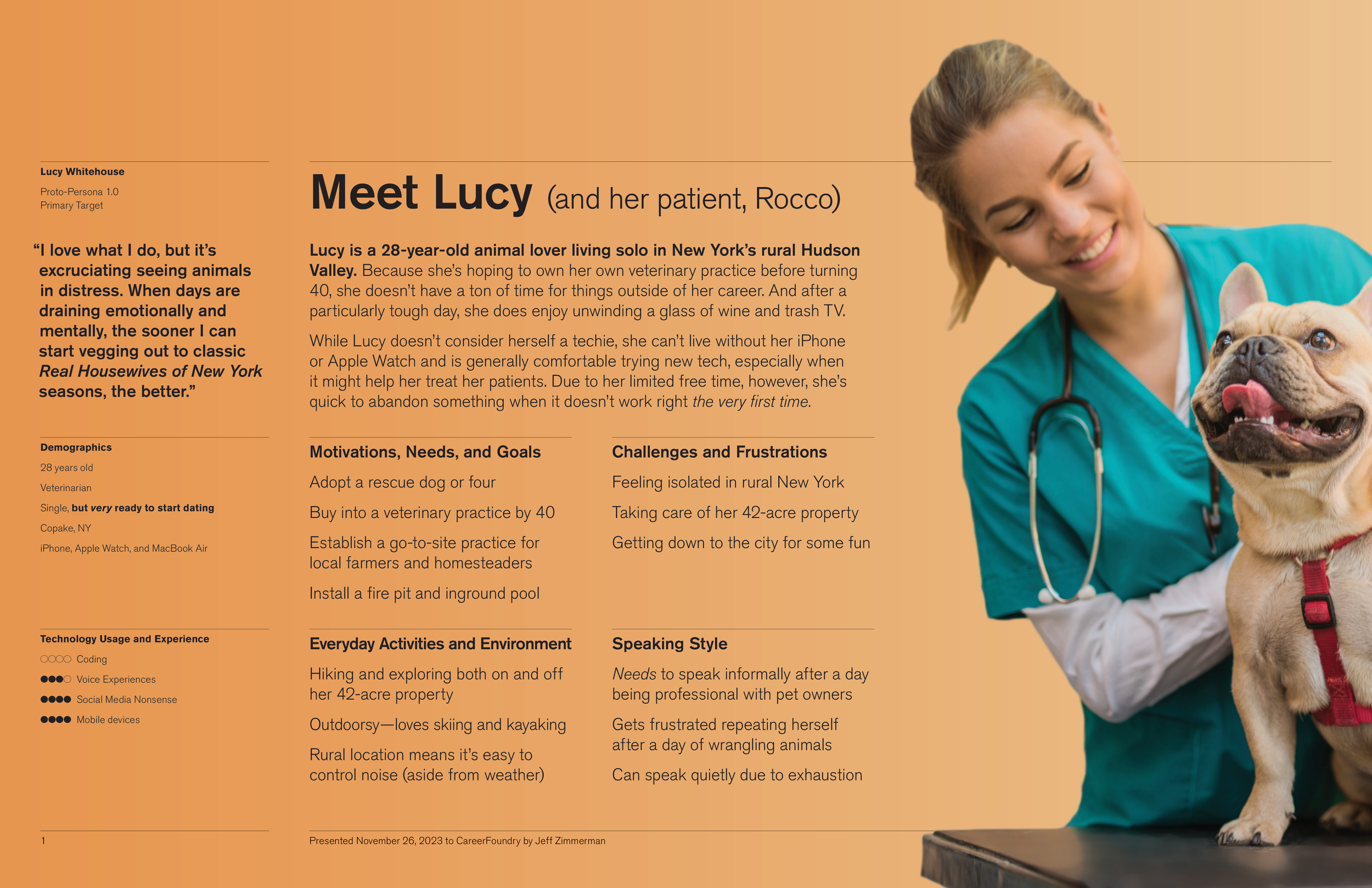
Process
Challenge
How can I use what I learned to create a better product?
Initial Development
How do UX design and code interplay when defining scope?
Testing
Does Quick Cuisine solve a real-world problem?
Stories and Personas
Who are my users? What are they trying to accomplish?
User Flows
How can I guide users to the solutions they need?
Coding, Building, and Certification
How do I put these together to create a functioning Alexa skill?
Retrospective
How did everything go?
Challenge
How can I use what I learned to create a better product?
Spirited Sips is my third certified Alexa skill developed as part of my UX design coursework at CareerFoundry. I’d love for you to try it out — but please be gentle! I’m working with the developer team to iron out some coding issues I uncovered in testing.
Spirited Sips began as a voice-only Alexa skill called Quick Cuisine that walks users through 5-minute food recipes. However, based on my user testing and experience managing the project within the constraints set forth, I felt that the project would benefit from a change to cocktail recipes.
Project at a Glance
Voice UX designer role
2 month timeline
CareerFoundry coursework with additional iteration post-certificate

Initial Development
How do UX design and code interplay when defining scope?
Throughout the main UX design course, I hadn’t realized just how much I was relying on my own professional experience to understand the scope of the projects. Given the inherent differences, I couldn’t easily map that experience onto a voice UX project.
Once I headed into the code, I realized that despite reflecting realistic conversations, my sample dialogues and voice scripts were too ambitious for a project without a dedicated coding partner. It was an important reminder to revisit and reevaluate scope throughout the course of a project.
However, once I understood how a voice project flows and how the script and code interact with one another, I hypothesized that these frameworks would better serve a cocktail recipe skill.
This gallery includes a selected overview of the Quick Cuisine development work that shaped Spirited Sips.
Techniques at a Glance
User stories for voice
User and system persona development
Sample dialogue writing
User flow development
Voice script writing
Code integration
Software at a Glance
Draw.io for user flows
Excel and Numbers for voice script writing
TextEdit for code writing
Alexa Developer Console for skill testing, certification, and distribution
InDesign for presentations

Testing
Does Quick Cuisine solve a real-world problem?
My research also raised some serious questions about the skill’s real-world use. While the audience represented by my initial persona most certainly does exist, the testing unearthed four reasons the project wouldn’t solve users’ problems as briefed:
Participants tended to search for recipes when they had short bits of down time, most often at work, to be sure they’d have all necessary ingredients prior to cooking.
Participants found my 5-minute recipes too simple. Said one participant, “I don’t need the lady in the tube to tell me how to make a grilled cheese.”
Participants wanted to search for meals by a base ingredient or protein they knew they already had.
Participants wanted variations on common recipes to make them more interesting or accommodate a missing ingredient.
Partnering with a chef or developer wasn't realistic for this project; however, the culture around cocktails inherently addresses or sidesteps the first three challenges, making a cocktail recipe app a viable alternative.
Techiniques at a Glance
Voice script refinement
Wizard of Oz qualitative testing via remote user interviews
Rainbow spreadsheet research synthesis
Software at a Glance
Zoom for user interviews
InDesign for presentations

Meet Rocco.
And his veterinarian, Lucy. He’s not normally this happy to see her.
Stories and Personas
Who are my users? What are they trying to accomplish?
While my stories did need some updating to reflect the product change, my personas were still pretty well aligned and needed only minor tweaks.
My primary persona, Lucy, is busily focused on her career, and an occasional after-work cocktail helps her unwind after a challenging day. My system persona, Lola, is a former bartender and mixology consultant helping restauranteurs and event coordinators develop interesting cocktail menus.
Techniques at a Glance
User stories, modified for two audience groups
User persona, modified to reflect the product change
System persona, modified to reflect the product change
Software at a Glance
Photoshop for user personas
InDesign for personas and presentations

User Flows
How can I guide users to the solutions they need?
Information architecture is even more essential to voice experiences. Because they are linear and often lack visuals, it can quickly become challenging for users to orient themselves.
There’s also a concurrent information architecture developers use to implement UX designers’ features, and the developers’ architecture balloons exponentially even as the number of variables increases just linearly.
Returning to the original scope allowed me to create a simple, four-bucket architecture — one for each base liquor. These aligned with the user flows I originally created for Quick Cuisine and test participants’ desire to search for recipes by a base ingredient.
Techniques at a Glance
User flows for user persona
Software at a Glance
Draw.io for user flows
InDesign for presentations

Coding, Building, and Certification
How do I put these together to create a functioning Alexa skill?
Armed with my as-yet-unaddressed script feedback from testing, I used the Alexa Developer Console to marry multiple JSON files and insert my own recipes and other script content. This turned out to be an excellent way to test my own understanding because I had to change Intents from meals to base liquors, among other utterances for multiple intents.
Feel free to take a look at the native code or test the certified app in Alexa’s skill store.
Technique at a Glance
Voice script writing
Code integration and building
Code testing
Software at a Glance
Excel and Numbers for script writing
TextEdit for code editing
Alexa Developer Console for skill testing, certification, and distribution
InDesign for presentations

Retrospective
How did everything go?
This project re-taught me a huge lesson about understanding scope — something that had become second nature as a creative director and visual designer. It underscored just how essential cross-practice relationships are, particularly with developers, and I’m excited to take on projects where I can work with developers to solve problems and create new features for users.
Despite needing a drink myself at times, my decision to change course based on my learning and research made the second half of the project more manageable. A product change so drastic may not always be practical or possible, but recognizing that something isn’t working and course-correcting is essential to meeting both user and business goals.
In time, I hope to partner with a developer to implement some of my stretch features including serving multiplication, searching by ingredient, and shopping list integration.
Project at a Glance
Voice UX designer role
2 month timeline
CareerFoundry coursework with additional iteration post-certificate




















